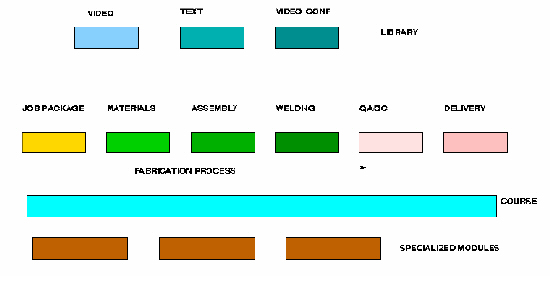
| ABOUT GLOBALMAT | |
| Objectives | |
| Partners | |
| Proposal | |
| Reports | |
| Members | |
| RESOURCES | |
| Portal | |
| Moodle | |
| Media server | |
| Just-in-Time courses | |
| METHODOLOGIES | |
| Blended Learning | |
| Activities Based Learning | |
| Just-in-Time Learning | |
| VCC | |
| PRESS ROOM | |
| Publications | |
| Presentations | |
| Newsletters | |
| Leaflet | |
| Poster | |
| GLOBALMAT on the web | |
|
|
|

GLOBALMAT blended learning design will focus on learning activities. A learning activity is a process including several steps that is based on actual welding processes that must be mastered by end users / welders. Two methods are foreseen for presenting content:
It could be a short introduction to the course followed by the training itself where the teacher goes through the course material and fetch the learning objects from libraries when needed. This could be text, streaming video, utilizing video conferencing with guest speakers and so forth. This means that the course is "empty" and the elements are used as the teacher requires the elements. The student s may be granted access to the library through the teacher or on a more general basis. This will require that we can store the objects and add metadata to them in order to identify them for later use. It will consequently require that we can search for these objects in a structured manner. The selection criteria and the metadata has also to be defined and structured.
The basic objects can be stored in the library and selected through the LD system. The next question will be: How should we present the knowledge? Since the courses will contain both theoretical content as well as practical content, and it will be used for the education of adult people, I assume that the best would be to present it in a way that is relevant for the student. The student will work in the industry and be part in a production process. If the course follows the fabrication process, it will start with a job order. A job order is a description of the task that are going to be done. The task contains a drawing, a description of how to carry out the job and a quality requirement for the product to be delivered. In order to be able to deliver, one must go through a number of steps from material, through assembly and welding, both theoretically and practically, through quality assurance of the job itself, ending up in a delivery of the job. One might then say that through such a process the student could either fetch background information from the library of learning objects or from sequences in course structure. The teacher could do the same as he/she progress through the course and presents new tasks in the job package. The student could also get different roles in such a scenario, being responsible for different actions. If this is done sub modules in the learning scenario could be developed in order to allow the student to go more in depth in different modules or topics.
|
|
copyright 2006-2008 GLOBALMAT consortium webmaster |
